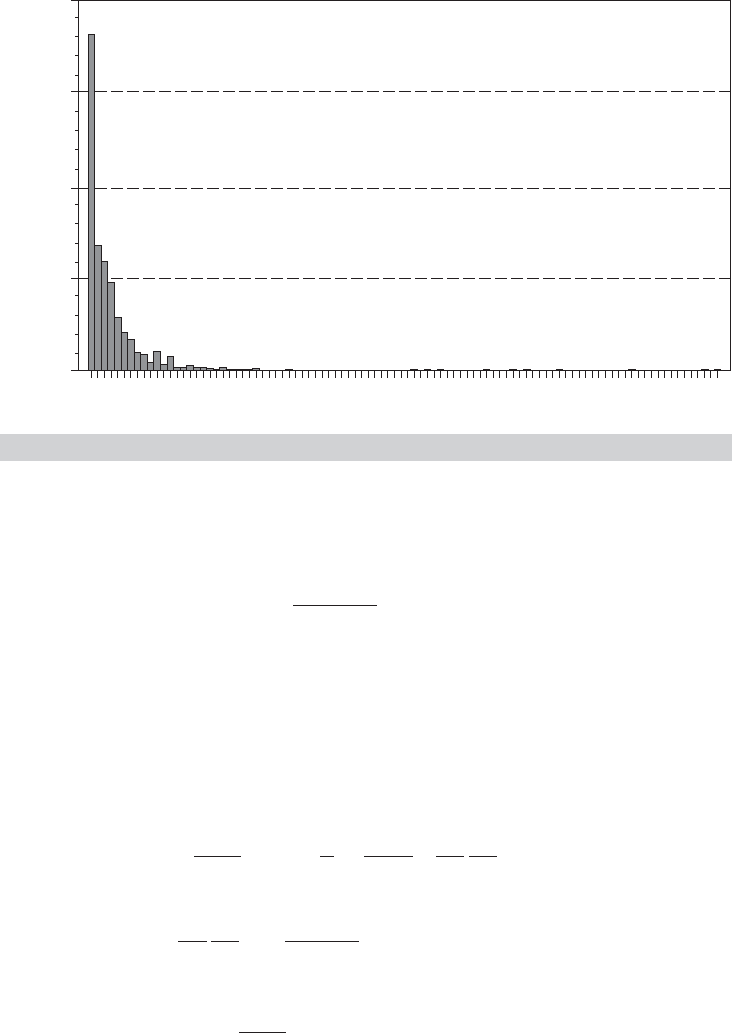Greene W.H. Econometric Analysis
Подождите немного. Документ загружается.


CHAPTER 14
✦
Maximum Likelihood Estimation
569
TABLE 14.6
Estimated Gamma Regression Model
(2)
(1) Constrained (3) (4)
NLS NLS MLE NLS/MLE
Constant 1.22468 1.69331 3.36826 3.36380
(47722.5) (0.04408) (0.05048) (0.04408)
Age −0.00207 −0.00207 −0.00153 −0.00207
(0.00061) (0.00061) (0.00061) (0.00061)
Education −0.04792 −0.04792 −0.04975 −0.04792
(0.00247) (0.00247) (0.00286) (0.00247)
Female 0.00658 0.00658 0.00696 0.00658
(0.01373) (0.01373) (0.01322) (0.08677)
θ 0.62699 — 5.31474 5.31474
(29921.3) — (0.10894) (0.00000)
The conditional mean function for this model is
E[y|x] = θ/μ( x) = θ exp(γ
1
+ x
γ
2
) = exp( γ
∗
1
+ x
γ
2
).
Table 14.6 presents estimates of θ and (γ
1
, γ
2
). Estimated standard errors appear in parenthe-
ses. The estimates in columns (1), (2) and (4) are all computed using nonlinear least squares.
In (1), an attempt is made to estimate θ and γ
1
separately. The estimator “converged” on two
values. However, the estimated standard errors are essentially infinite. The convergence to
anything at all is due to rounding error in the computer. The results in column (2) are for γ
∗
1
and
γ
2
. The sums of squares for these two estimates as well as for those in (4) are all 112.19688,
indicating that the three results merely show three different sets of results for which γ
∗
1
is the
same. The full maximum likelihood estimates are presented in (3). Note that an estimate of
θ is obtained here because the assumed gamma distribution provides another independent
moment equation for this parameter, ∂ ln L/∂θ =−n ln ( θ) +
i
(lny
i
− ln μ( x)) = 0, while
the normal equations for the sum of squares provides the same normal equation for θ and γ
1
.
The standard approach to modeling counts of events begins with the Poisson re-
gression model,
Prob[Y = y
i
|x
i
] =
exp(−λ
i
)λ
y
i
i
y
i
!
,λ
i
= exp(x
i
β), y
i
= 0, 1,...
which has loglinear conditional mean function E[y
i
|x
i
] = λ
i
. (The Poisson regression
model and other specifications for data on counts are discussed at length in Chapter 18.
We introduce the topic here to begin development of the MLE in a fairly straight-
forward, typical nonlinear setting.) Appendix Table F7.1 presents the Riphahn et al.
(2003) data, which we will use to analyze a count variable, DocVis, the number of visits
to physicans in the survey year. The histogram in Figure 14.4 shows a distinct spike at
zero followed by rapidly declining frequencies. While the Poisson distribution, which
is typically hump-shaped, can accommodate this configuration if λ
i
is less than one,
the shape is nonetheless somewhat “non-Poisson.” [So-called Zero Inflation models
(discussed in Chapter 18) are often used for this situation.]
The geometric distribution,
f (y
i
|x
i
) = θ
i
(1 − θ
i
)
y
i
,θ
i
= 1/(1 + λ
i
), λ
i
= exp(x
i
β), y
i
= 0, 1,...,
is a convenient specification that produces the effect shown in Figure 14.4. (Note that,
formally, the specification is used to model the number of failures before the first success

570
PART III
✦
Estimation Methodology
0
0 5 10 15 20 25 30 35 40 45 50 55 60 65 70 75 80 85 90 95
DOCVIS
636
1272
1908
2544
Frequency
FIGURE 14.4
Histogram for Doctor Visits.
in successive independent trials each with success probability θ
i
, so in fact, it is misspec-
ified as a model for counts. The model does provide a convenient and useful illustration,
however.) The conditional mean function is also E[y
i
|x
i
] = λ
i
. The partial effects in
the model are
∂ E[y
i
|x
i
]
∂x
i
= λ
i
β,
so this is a distinctly nonlinear regression model. We will construct a maximum likeli-
hood estimator, then compare the MLE to the nonlinear least squares and (misspecified)
linear least squares estimates.
The log-likelihood function is
ln L =
n
i=1
ln f (y
i
|x
i
, β) =
n
i=1
ln θ
i
+ y
i
ln(1 − θ
i
).
The likelihood equations are
∂ ln L
∂β
=
n
i=1
1
θ
i
−
y
i
1 − θ
i
dθ
i
dλ
i
∂λ
i
∂β
= 0.
Because
dθ
i
dλ
i
∂λ
i
∂β
=
−1
(1 + λ
i
)
2
λ
i
x
i
=−θ
i
(1 − θ
i
)x
i
,
the likelihood equations simplify to
∂ ln L
∂β
=
n
i=1
(θ
i
y
i
− (1 − θ
i
))x
i
=
n
i=1
(θ
i
(1 + y
i
) − 1)x
i
.

CHAPTER 14
✦
Maximum Likelihood Estimation
571
To estimate the asymptotic covariance matrix, we can use any of the three estimators
of Asy. Var [
ˆ
β
MLE
]. The BHHH estimator would be
Est. Asy. Var
BHHH
[
ˆ
β
MLE
] =
n
i=1
∂ ln f (y
i
|x
i
,
ˆ
β)
∂
ˆ
β
∂ ln f (y
i
|x
i
,
ˆ
β)
∂
ˆ
β
−1
=
n
i=1
(
ˆ
θ
i
(1 + y
i
) − 1)
2
x
i
x
i
.
The negative inverse of the second derivatives matrix evaluated at the MLE is
−
∂
2
ln L
∂
ˆ
β∂
ˆ
β
−1
=
n
i=1
(1 + y
i
)
ˆ
θ
i
(1 −
ˆ
θ
i
)x
i
x
i
−1
.
Finally, as noted earlier, E[y
i
| x
i
] = λ
i
= (1 − θ
i
)/θ
i
, is known, so we can also use the
negative inverse of the expected second derivatives matrix,
−E
∂
2
ln L
∂
ˆ
β∂
ˆ
β
−1
=
n
i=1
(1 −
ˆ
θ
i
)x
i
x
i
−1
.
To compute the estimates of the parameters, either Newton’s method,
ˆ
β
t+1
=
ˆ
β
t
−
ˆ
H
t
−1
ˆ
g
t
,
or the method of scoring,
ˆ
β
t+1
=
ˆ
β
t
−
E[
ˆ
H
t
]
−1
ˆ
g
t
,
can be used, where H and g are the second and first derivatives that will be evaluated
at the current estimates of the parameters. Like many models of this sort, there is a
convenient set of starting values, assuming the model contains a constant term. Because
E[y
i
|x
i
] = λ
i
, if we start the slope parameters at zero, then a natural starting value for
the constant term is the log of ¯y.
Example 14.10 Geometric Regression Model for Doctor Visits
In Example 7.6, we considered nonlinear least squares estimation of a loglinear model for the
number of doctor visits variable shown in Figure 14.4. The data are drawn from the Riphahn
et al. (2003) data set in Appendix Table F7.1. We will continue that analysis here by fitting a
more detailed model for the count variable DocVis. The conditional mean analyzed here is
ln E[DocVis
it
|x
it
] = β
1
+ β
2
Age
it
+ β
3
Educ
it
+ β
4
Income
it
+ β
5
Kids
it
(This differs slightly from the model in Example 11.14. For this exercise, with an eye toward
the fixed effects model in Example 14.13), we have specified a model that does not contain
any time-invariant variables, such as Female
i
.) Sample means for the variables in the model
are given in Table 14.7. Note, these data are a panel. In this exercise, we are ignoring that
fact, and fitting a pooled model. We will turn to panel data treatments in the next section,
and revisit this application.

572
PART III
✦
Estimation Methodology
We used Newton’s method for the optimization, with starting values as suggested earlier.
The five iterations are as follows:
Variable Constant Age Educ Income Kids
Start values: 0.11580e+01 0.00000e+00 0.00000e+00 0.00000e+00 0.00000e+00
1st derivs. −0.25191e−08 −0.61777e+05 0.73202e+04 0.42575e+04 0.16464e+04
Parameters: 0.11580e+01 0.00000e+00 0.00000e+00 0.00000e+00 0.00000e+00
Iteration 1 F = 0.6287e+05 g
inv(H)g = 0.4367e+02
1st derivs. 0.48616e+03 −0.22449e+05 −0.57162e+04 −0.17112e+04 −0.16521e+03
Parameters: 0.11186e+01 0.17563e−01 −0.50263e−01 −0.46274e−01 −0.15609e+00
Iteration 2 F = 0.6192e+05 g
inv(H)g = 0.3547e+01
1st derivs. −0.31284e+01 −0.15595e+03 −0.37197e+02 −0.10630e+02 −0.77186e+00
Parameters: 0.10922e+01 0.17981e−01 −0.47303e−01 −0.46739e−01 −0.15683e+00
Iteration 3 F= 0.6192e+05 g
inv(H)g = 0.2598e−01
1st derivs. −0.18417e−03 −0.99368e−02 −0.21992e−02 −0.59354e−03 −0.25994e−04
Parameters: 0.10918e+01 0.17988e−01 −0.47274e−01 −0.46751e−01 −0.15686e+00
Iteration 4 F= 0.6192e+05 g
inv(H)g = 0.1831e−05
1st derivs. −0.35727e−11 0.86745e−10 −0.26302e−10 −0.61006e−11 −0.15620e−11
Parameters: 0.10918e+01 0.17988e−01 −0.47274e−01 −0.46751e−01 −0.15686e+00
Iteration 5 F= 0.6192e+05 g
inv(H)g = 0.1772e−12
Convergence based on the LM criterion, g
H
−1
g is achieved after the fourth iteration. Note
that the derivatives at this point are extremely small, albeit not absolutely zero. Table 14.7
presents the maximum likelihood estimates of the parameters. Several sets of standard er-
rors are presented. The three sets based on different estimators of the information matrix
are presented first. The fourth set are based on the cluster corrected covariance matrix
discussed in Section 14.8.4. Because this is actually an (unbalanced) panel data set, we
anticipate correlation across observations. Not surprisingly, the standard errors rise sub-
stantially. The partial effects listed next are computed in two ways. The “Average Partial
Effect” is computed by averaging λ
i
β across the individuals in the sample. The “Partial
Effect” is computed for the average individual by computing λ at the means of the data.
The next-to-last column contains the ordinary least squares coefficients. In this model,
there is no reason to expect ordinary least squares to provide a consistent estimator of
β. The question might arise, What does ordinary least squares estimate? The answer is the
slopes of the linear projection of DocVis on x
it
. The resemblance of the OLS coefficients
to the estimated partial effects is more than coincidental, and suggests an answer to the
question.
The analysis in the table suggests three competing approaches to modeling DocVis. The
results for the geometric regression model are given in Table 14.7. At the beginning of this
section, we noted that the more conventional approach to modeling a count variable such as
DocVis is with the Poisson regression model. The log-likelihood function and its derivatives
TABLE 14.7
Estimated Geometric Regression Model Dependent Variable: DocVis:
Mean
=
3.18352, Standard Deviation
=
5.68969
St. Er. St. Er. St. Er. St. Er. PE
Variable Estimate H E[H] BHHH Cluster APE Mean OLS Mean
Constant 1.0918 0.0524 0.0524 0.0354 0.1112 — — 2.656
Age 0.0180 0.0007 0.0007 0.0005 0.0013 0.0572 0.0547 0.061 43.52
Education −0.0473 0.0033 0.0033 0.0023 0.0069 −0.150 −0.144 −0.121 11.32
Income −0.0468 0.0041 0.0042 0.0023 0.0075 −0.149 −0.142 −0.162 3.52
Kids −0.1569 0.0156 0.0155 0.0103 0.0319 −0.499 −0.477 −0.517 0.40

CHAPTER 14
✦
Maximum Likelihood Estimation
573
TABLE 14.8
Estimates of Three Models for DOCVIS
Geometric Model Poisson Model Nonlinear Reg.
Variable Estimate St. Er. Estimate St. Er. Estimate St. Er.
Constant 1.0918 0.0524 1.0480 0.0272 0.9801 0.0893
Age 0.0180 0.0007 0.0184 0.0003 0.0187 0.0011
Education −0.0473 0.0033 −0.0433 0.0017 −0.0361 0.0057
Income −0.0468 0.0041 −0.0520 0.0022 −0.0591 0.0072
Kids −0.1569 0.0156 −0.1609 0.0080 −0.1692 0.0264
are even simpler than the geometric model,
ln L =
n
i =1
y
i
ln λ
i
− λ
i
− ln y
i
!,
∂ ln L/∂β =
n
i =1
( y
i
− λ
i
)x
i
,
∂
2
ln L/∂β∂β
=
n
i =1
−λ
i
x
i
x
i
.
A third approach might be a semiparametric, nonlinear regression model,
y
it
= exp(x
it
β) + ε
it
.
This is, in fact, the model that applies to both the geometric and Poisson cases. Under
either distributional assumption, nonlinear least squares is inefficient compared to MLE.
But, the distributional assumption can be dropped altogether, and the model fit as a simple
exponential regression. Table 14.8 presents the three sets of estimates.
It is not obvious how to choose among the alternatives. Of the three, the Poisson model is
used most often by far. The Poisson and geometric models are not nested, so we cannot use
a simple parametric test to choose between them. However, these two models will surely fit
the conditions for the Vuong test described in Section 14.6.6. To implement the test, we first
computed
V
it
= ln f
it
|geometric − ln f
it
|Poisson
using the respective MLEs of the parameters. The test statistic given in Section 14.6.6 is then
V =
n
i =1
T
i
¯
V
s
V
.
This statistic converges to standard normal under the underlying assumptions. A large posi-
tive value favors the geometric model. The computed sample value is 37.885, which strongly
favors the geometric model over the Poisson.
14.9.6 PANEL DATA APPLICATIONS
Application of panel data methods to the linear panel data models we have considered
so far is a fairly marginal extension. For the random effects linear model, considered in
the following Section 14.9.6.a, the MLE of β is, as always, FGLS given the MLEs of the
variance parameters. The latter produce a fairly substantial complication, as we shall

574
PART III
✦
Estimation Methodology
see. This extension does provide a convenient, interesting application to see the payoff
to the invariance property of the MLE—we will reparameterize a fairly complicated
log-likelihood function to turn it into a simple one. Where the method of maximum like-
lihood becomes essential is in analysis of fixed and random effects in nonlinear models.
We will develop two general methods for handling these situations in generic terms in
Sections 14.9.6.b and 14.9.6.c, then apply them in several models later in the book.
14.9.6.a ML Estimation of the Linear Random Effects Model
The contribution of the ith individual to the log-likelihood for the random effects model
[(11-28) to (11-31)] with normally distributed disturbances is
ln L
i
β,σ
2
ε
,σ
2
u
=
−1
2
T
i
ln 2π + ln |
i
|+(y
i
− X
i
β)
−1
i
(y
i
− X
i
β)
(14-89)
=
−1
2
T
i
ln 2π + ln |
i
|+ε
i
−1
i
ε
i
,
where
i
= σ
2
ε
I
Ti
+ σ
2
u
ii
,
and i denotes a T
i
×1 column of ones. Note that the
i
varies over i because it is T
i
×T
i
.
Baltagi (2005, pp. 19–20) presents a convenient and compact estimator for this model
that involves iteration between an estimator of φ
2
=
σ
2
ε
/(σ
2
ε
+ Tσ
2
u
)
, based on sums
of squared residuals, and (α, β,σ
2
ε
) (α is the constant term) using FGLS. Unfortunately,
the convenience and compactness come unraveled in the unbalanced case. We consider,
instead, what Baltagi labels a “brute force” approach, that is, direct maximization of
the log-likelihood function in (14-89). (See, op. cit, pp. 169–170.)
Using (A-66), we find (in (11-28) that
−1
i
=
1
σ
2
ε
I
T
i
−
σ
2
u
σ
2
ε
+ T
i
σ
2
u
ii
.
We will also need the determinant of
i
. To obtain this, we will use the product of its
characteristic roots. First, write
|
i
|=
σ
2
ε
T
i
|I + γ ii
|,
where γ = σ
2
u
/σ
2
ε
. To find the characteristic roots of the matrix, use the definition
[I + γ ii
]c = λc,
where c is a characteristic vector and λ is the associated characteristic root. The equation
implies that γ ii
c = (λ − 1)c. Premultiply by i
to obtain γ(i
i)(i
c) = (λ − 1)(i
c). Any
vector c with elements that sum to zero will satisfy this equality. There will be T
i
− 1
such vectors and the associated characteristic roots will be (λ − 1) = 0orλ = 1. For
the remaining root, divide by the nonzero (i
c) and note that i
i = T
i
, so the last root is
T
i
γ = λ − 1orλ = (1 + T
i
γ).
24
It follows that the determinant is
ln |
i
|=T
i
ln σ
2
ε
+ ln(1 + T
i
γ).
24
By this derivation, we have established a useful general result. The characteristic roots of a T × T matrix
of the form A = (I + abb
) are 1 with multiplicity (T − 1) and ab
b with multiplicity 1. The proof follows
precisely along the lines of our earlier derivation.

CHAPTER 14
✦
Maximum Likelihood Estimation
575
Expanding the parts and multiplying out the third term gives the log-likelihood function
ln L =
n
i=1
ln L
i
=−
1
2
ln 2π + ln σ
2
ε
n
i=1
T
i
+
n
i=1
ln(1 + T
i
γ)
−
1
2σ
2
ε
n
i=1
ε
i
ε
i
−
σ
2
u
(T
i
¯ε
i
)
2
σ
2
ε
+ T
i
σ
2
u
.
Note that in the third term, we can write σ
2
ε
+ T
i
σ
2
u
= σ
2
ε
(1 + T
i
γ)and σ
2
u
= σ
2
ε
γ . After
inserting these, two appearances of σ
2
ε
in the square brackets will cancel, leaving
ln L =−
1
2
n
i=1
T
i
ln 2π + ln σ
2
ε
+ ln(1 + T
i
γ)+
1
σ
2
ε
ε
i
ε
i
−
γ(T
i
¯ε
i
)
2
1 + T
i
γ
.
Now, let θ = 1/σ
2
ε
, R
i
= 1 + T
i
γ, and Q
i
= γ/R
i
. The individual contribution to the
log-likelihood becomes
ln L
i
=−
1
2
[θ(ε
i
ε
i
− Q
i
(T
i
¯ε
i
)
2
) + ln R
i
− T
i
ln θ + T
i
ln 2π ].
The likelihood equations are
∂ ln L
i
∂β
= θ
T
i
t=1
x
it
ε
it
− θ
Q
i
T
i
t=1
x
it
Ti
t=1
ε
it
,
∂ ln L
i
∂θ
=−
1
2
⎡
⎣
T
i
t=1
ε
2
it
− Q
i
T
i
t=1
ε
it
2
−
T
i
θ
⎤
⎦
,
∂ ln L
i
∂γ
=
1
2
⎡
⎣
θ
⎛
⎝
1
R
2
i
T
i
t=1
ε
it
2
⎞
⎠
−
T
i
R
i
⎤
⎦
.
These will be sufficient for programming an optimization algorithm such as DFP or
BFGS. (See Section E3.3.) We could continue to derive the second derivatives for
computing the asymptotic covariance matrix, but this is unnecessary. For
ˆ
β
MLE
,we
know that because this is a generalized regression model, the appropriate asymptotic
covariance matrix is
Asy. Var[
ˆ
β
MLE
] =
n
i=1
X
i
ˆ
−1
i
X
i
−1
.
(See Section 11.5.1.) We also know that the MLEs of the variance components estima-
tors will be asymptotically uncorrelated with that of β. In principle, we could continue
to estimate the asymptotic variances of the MLEs of σ
2
ε
and σ
2
u
. It would be necessary to
derive these from the estimators of θ and γ , which one would typically do in any event.
However, statistical inference about the disturbance variance, σ
2
ε
in a regression model,
is typically of no interest. On the other hand, one might want to test the hypothesis that
σ
2
u
equals zero, or γ = 0. Breusch and Pagan’s (1979) LM statistic in (11-42) extended

576
PART III
✦
Estimation Methodology
to the unbalanced panel case considered here would be
LM =
N
i=1
T
i
2
2
N
i=1
T
i
(T
i
− 1)
N
i=1
(T
i
¯e
i
)
2
N
i=1
T
i
t=1
e
2
it
− 1
2
=
N
i=1
T
i
2
2
N
i=1
T
i
(T
i
− 1)
N
i=1
[(T
i
¯e
i
)
2
− e
i
e
i
]
N
i=1
e
i
e
i
2
.
Example 14.11 Maximum Likelihood and FGLS Estimates of a
Wage Equation
Examples 11.5 and 11.6 presented FGLS estimates of a wage equation using Cornwell and
Rupert’s panel data. We have reestimated the wage equation using maximum likelihood
instead of FGLS. The parameter estimates appear in Table 14.9, with the FGLS and pooled
OLS estimates. The estimates of the variance components are shown in the table as well.
The similarity of the MLEs and FGLS estimates is to be expected given the large sample size.
The LM statistic for testing for the presence of the common effects is 3,881.34, which is far
larger than the critical value of 3.84. With the MLE, we can also use an LR test to test for
random effects against the null hypothesis of no effects. The chi-squared statistic based on
the two log-likelihoods is 4,297.57, which leads to the same conclusion.
14.9.6.b Nested Random Effects
Consider a data set on test scores for multiple school districts in a state. To establish a
notation for this complex model, we define a four-level unbalanced structure,
Z
ijkt
= test score for student t, teacher k, school j, district i,
L = school districts, i = 1,...,L,
M
i
= schools in each district, j = 1,...,M
i
,
N
ij
= teachers in each school, k = 1,...,N
ij
T
ijk
= students in each class, t = 1,...,T
ijk
.
TABLE 14.9
Estimates of the Wage Equation
Pooled Least Squares Random Effects MLE Random Effects FGLS
Variable Estimate Std. Error
a
Estimate Std. Error Estimate Std. Error
Exp 0.0361 0.004533 0.1078 0.002480 0.08906 0.002280
Exp
2
−0.0006550 0.0001016 −0.0005054 0.00005452 −0.0007577 0.00005036
Wks 0.004461 0.001728 0.0008663 0.0006031 0.001066 0.0005939
Occ −0.3176 0.02726 −0.03954 0.01374 −0.1067 0.01269
Ind 0.03213 0.02526 0.008807 0.01531 −0.01637 0.01391
South −0.1137 0.02868 −0.01615 0.03201 −0.06899 0.02354
SMSA 0.1586 0.02602 −0.04019 0.01901 −0.01530 0.01649
MS 0.3203 0.03494 −0.03540 0.01880 −0.02398 0.01711
Union 0.06975 0.02667 0.03306 0.01482 0.03597 0.01367
Constant 5.8802 0.09673 4.8197 0.06035 5.3455 0.04361
σ
2
ε
0.146119 0.023436 (θ = 42.66926) 0.023102
σ
2
u
0 0.876517 (γ = 37.40035) 0.838361
ln L −1899.537 249.25 —
a
Robust standard errors

CHAPTER 14
✦
Maximum Likelihood Estimation
577
Thus, from the outset, we allow the model to be unbalanced at all levels. In general
terms, then, the random effects regression model would be
y
ijkt
= x
ijkt
β + u
ijk
+ v
ij
+ w
i
+ ε
ijkt
.
Strict exogeneity of the regressors is assumed at all levels. All parts of the disturbance
are also assumed to be uncorrelated. (A normality assumption will be added later as
well.) From the structure of the disturbances, we can see that the overall covariance
matrix, , is block-diagonal over i, with each diagonal block itself block-diagonal in
turn over j, each of these is block-diagonal over k, and, at the lowest level, the blocks,
for example, for the class in our example, have the form for the random effects model
that we saw earlier.
Generalized least squares has been well worked out for the balanced case. [See, for
example, Baltagi, Song, and Jung (2001), who also provide results for the three-level
unbalanced case.] Define the following to be constructed from the variance components,
σ
2
ε
, σ
2
u
, σ
2
v
, and σ
2
w
:
σ
2
1
= Tσ
2
u
+ σ
2
ε
,
σ
2
2
= NTσ
2
v
+ Tσ
2
u
+ σ
2
ε
= σ
2
1
+ NTσ
2
v
,
σ
2
3
= MNTσ
2
w
+ NTσ
2
v
+ Tσ
2
u
+ σ
2
ε
= σ
2
2
+ MNTσ
2
w
.
Then, full generalized least squares is equivalent to OLS regression of
˜y
ijkt
= y
ijkt
−
1 −
σ
ε
σ
1
¯y
ijk
. −
σ
ε
σ
1
−
σ
ε
σ
2
¯y
ij
..−
σ
ε
σ
2
−
σ
ε
σ
3
¯y
i
...
on the same transformation of x
ijkt
. FGLS estimates are obtained by three groupwise
between estimators and the within estimator for the innermost grouping.
The counterparts for the unbalanced case can be derived [see Baltagi et al. (2001)],
but the degree of complexity rises dramatically. As Antwiler (2001) shows, however,
if one is willing to assume normality of the distributions, then the log-likelihood is
very tractable. (We note an intersection of practicality with nonrobustness.) Define the
variance ratios
ρ
u
=
σ
2
u
σ
2
ε
,ρ
v
=
σ
2
v
σ
2
ε
,ρ
w
=
σ
2
w
σ
2
ε
.
Construct the following intermediate results:
θ
ijk
= 1 + T
ijk
ρ
u
,φ
ij
=
N
ij
k=1
T
ijk
θ
ijk
,θ
ij
= 1 + φ
ij
ρ
v
,φ
i
=
M
i
j=1
φ
ij
θ
ij
,θ
i
= 1 + ρ
w
φ
i
and sums of squares of the disturbances e
ijkt
= y
ijkt
− x
ijkt
β,
A
ijk
=
T
ijk
t=1
e
2
ijkt
,
B
ijk
=
T
ijk
t=1
e
ijkt
, B
ij
=
N
ij
k=1
B
ijk
θ
ijk
, B
i
=
M
i
j=1
B
ij
θ
ij
.

578
PART III
✦
Estimation Methodology
The log-likelihood is
ln L =−
1
2
H ln
2πσ
2
ε
−
1
2
⎡
⎣
L
i=1
⎧
⎨
⎩
ln θ
i
+
M
i
j=1
⎧
⎨
⎩
ln θ
ij
+
N
ij
k=1
+
ln θ
ijk
+
A
ijk
σ
2
ε
−
ρ
u
θ
ijk
B
2
ijk
σ
2
ε
,
−
ρ
v
θ
ij
B
2
ij
σ
2
ε
⎫
⎬
⎭
−
ρ
w
θ
i
B
2
i
σ
2
ε
⎫
⎬
⎭
⎤
⎦
,
where H is the total number of observations. (For three levels, L = 1 and ρ
w
= 0.)
Antwiler (2001) provides the first derivatives of the log-likelihood function needed to
maximize ln L. However, he does suggest that the complexity of the results might make
numerical differentiation attractive. On the other hand, he finds the second derivatives
of the function intractable and resorts to numerical second derivatives in his application.
The complex part of the Hessian is the cross derivatives between β and the variance
parameters, and the lower right part for the variance parameters themselves. However,
these are not needed. As in any generalized regression model, the variance estimators
and the slope estimators are asymptotically uncorrelated. As such, one need only invert
the part of the matrix with respect to β to get the appropriate asymptotic covariance
matrix. The relevant block is
−
∂
2
ln L
∂β∂β
=
1
σ
2
ε
L
i=1
M
i
j=1
N
ij
k=1
T
ijk
t=1
x
ijkt
x
ijkt
−
ρ
w
σ
2
ε
L
i=1
M
i
j=1
N
ij
k=1
1
θ
ijk
⎛
⎝
T
ijk
t=1
x
ijkt
⎞
⎠
⎛
⎝
T
ijk
t=1
x
ijkt
⎞
⎠
−
ρ
v
σ
2
ε
L
i=1
M
i
j=1
1
θ
ij
⎛
⎝
N
ij
k=1
1
θ
ijk
⎛
⎝
T
ijk
t=1
x
ijkt
⎞
⎠
⎞
⎠
⎛
⎝
N
ij
k=1
1
θ
ijk
⎛
⎝
T
ijk
t=1
x
ijkt
⎞
⎠
⎞
⎠
−
ρ
u
σ
2
ε
L
i=1
⎛
⎝
M
i
j=1
1
θ
ij
⎛
⎝
N
ij
k=1
1
θ
ijk
⎛
⎝
T
ijk
t=1
x
ijkt
⎞
⎠
⎞
⎠
⎞
⎠
⎛
⎝
M
i
j=1
1
θ
ij
⎛
⎝
N
ij
k=1
1
θ
ijk
⎛
⎝
T
ijk
t=1
x
ijkt
⎞
⎠
⎞
⎠
⎞
⎠
.
The maximum likelihood estimator of β is FGLS based on the maximum likelihood
estimators of the variance parameters. Thus, expression (14-90) provides the appropriate
covariance matrix for the GLS or maximum likelihood estimator. The difference will
be in how the variance components are computed. Baltagi et al. (2001) suggest a variety
of methods for the three-level model. For more than three levels, the MLE becomes
more attractive.
Given the complexity of the results, one might prefer simply to use OLS in spite
of its inefficiency. As might be expected, the standard errors will be biased owing to
the correlation across observations; there is evidence that the bias is downward. [See
Moulton (1986).] In that event, the robust estimator in (11-4) would be the natural
alternative. In the example given earlier, the nesting structure was obvious. In other
cases, such as our application in Example 11.12, that might not be true. In Example 14.12
[and in the application in Baltagi (2005)], statewide observations are grouped into
regions based on intuition. The impact of an incorrect grouping is unclear. Both OLS and
FGLS would remain consistent—both are equivalent to GLS with the wrong weights,
which we considered earlier. However, the impact on the asymptotic covariance matrix
for the estimator remains to be analyzed.
